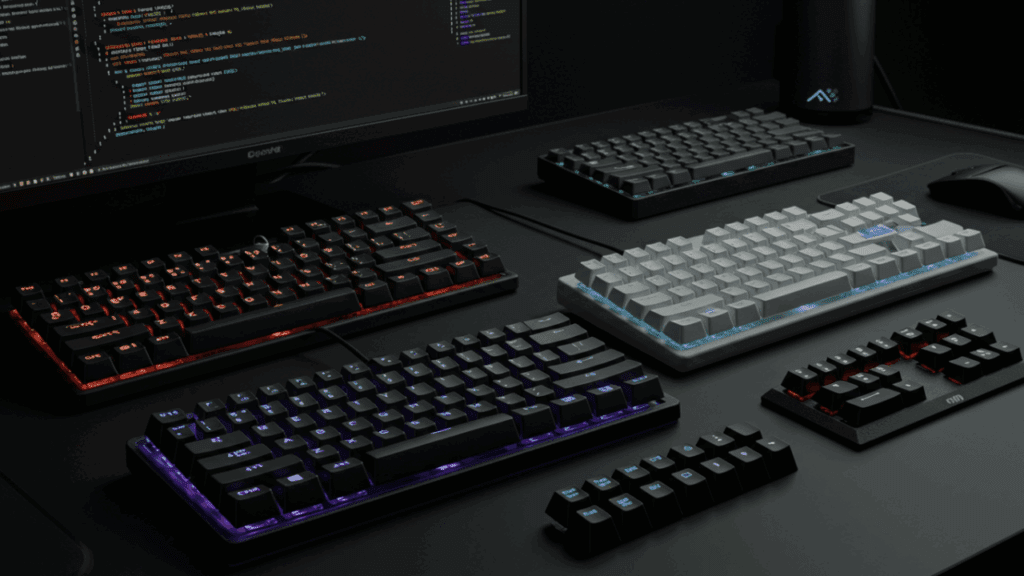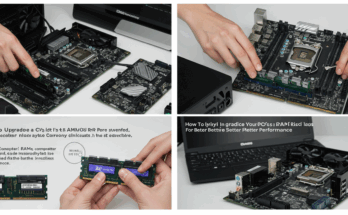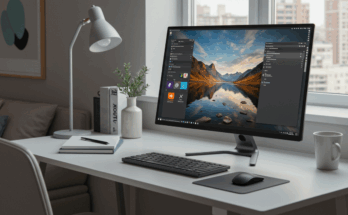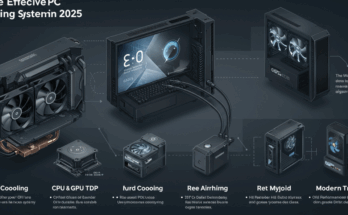As a programmer, your keyboard is more than just a tool—it’s your primary interface for transforming ideas into code. In 2025, the market is brimming with keyboards designed to enhance productivity, reduce strain, and elevate the coding experience. Whether you’re debugging complex algorithms, crafting clean code, or working late into the night, the right keyboard can make all the difference. This article dives into the best keyboards for programmers, focusing on ergonomics, tactile feedback, customization, and connectivity. We’ve curated a list of top models based on build quality, user experience, and features tailored to coders’ needs, ensuring you find the perfect fit for your workflow.
Why Choosing the Right Keyboard Matters for Programmers
Programmers spend hours typing, often in high-pressure environments where efficiency and comfort are paramount. A poorly designed keyboard can lead to wrist strain, reduced typing speed, and even long-term health issues like carpal tunnel syndrome. According to a 2024 Stack Overflow Developer Survey, nearly 25% of programmers report hand or wrist pain, underscoring the importance of ergonomic design. The best keyboards for coding offer tactile feedback for precise typing, customizable layouts for streamlined workflows, and durable builds to withstand years of heavy use. Whether you prefer the satisfying click of mechanical switches or the quiet efficiency of low-profile keys, the keyboards below are engineered to keep you coding comfortably and efficiently.

Top Keyboards for Programmers in 2025
Keychron Q5 Max: The Ultimate Customizable Coding Companion
The Keychron Q5 Max stands out as the best overall keyboard for programmers in 2025, blending premium build quality with unmatched versatility. This compact 96% keyboard offers a near-full-size layout, including a numpad, without taking up excessive desk space. Its double-gasket-mounted design delivers a soft, springy typing feel, reducing fatigue during long coding sessions. The Q5 Max supports hot-swappable switches, allowing you to swap out the stock Gateron Jupiter switches for your preferred linear or tactile options without soldering. With tri-mode connectivity (Bluetooth 5.1, 2.4GHz wireless, and USB-C), it seamlessly switches between devices, making it ideal for coders working across multiple systems. The customizable RGB lighting and QMK/VIA programmability let you tailor keymaps and macros to your specific coding needs, boosting productivity. While it’s pricier than some competitors, its premium feel and flexibility make it a worthy investment for serious programmers.
Logitech MX Keys S: Sleek and Ergonomic for Long Hours
For programmers who prioritize ergonomics and a low-profile typing experience, the Logitech MX Keys S is a standout choice. This wireless keyboard features a sleek, minimalist design with low-profile membrane keys that provide a quiet, comfortable typing experience. Its smart backlighting activates based on hand proximity, conserving battery life while illuminating keys during late-night coding marathons. The MX Keys S supports multi-device pairing via Bluetooth or Logi Bolt, allowing you to switch between your laptop, desktop, and tablet with ease. The slightly curved keycaps and cushioned palm rest reduce wrist strain, making it ideal for coders who type for extended periods. While it lacks the tactile feedback of mechanical keyboards, its smooth, quiet operation and long battery life (up to 10 days with backlighting) make it perfect for distraction-free coding in shared workspaces.
Kinesis Advantage360: The Ergonomic Powerhouse
The Kinesis Advantage360 redefines ergonomic design with its split, contoured layout that positions your hands in a natural, relaxed stance. This mechanical keyboard is a game-changer for programmers prone to wrist pain or those seeking maximum comfort during marathon coding sessions. Its hot-swappable switches and fully programmable keys via QMK firmware allow you to customize every aspect of your typing experience, from actuation force to key assignments. The Advantage360 supports both wired and Bluetooth connectivity, offering flexibility for coders on the go. While its unconventional design has a learning curve and a premium price tag ($399–$429), its ability to reduce strain and boost productivity makes it a top choice for health-conscious programmers.
Corsair K100 RGB: High-Performance Versatility
The Corsair K100 RGB is a full-size mechanical keyboard that excels in both coding and gaming, making it a versatile option for programmers who dabble in both. Equipped with Cherry MX Speed or Corsair OPX switches, it offers lightning-fast actuation for rapid typing. The keyboard’s robust PBT keycaps and aluminum frame ensure durability, while the included wrist rest provides comfort during extended use. With Corsair’s iCUE software, you can program six dedicated macro keys to execute complex commands or shortcuts, streamlining your coding workflow. The vibrant RGB lighting is fully customizable, adding a touch of flair to your setup. While its size may be a drawback for those with limited desk space, the K100 RGB’s performance and programmability make it a favorite among developers who value speed and precision.
Epomaker SK71: Compact and Budget-Friendly
For programmers seeking a compact, budget-friendly option, the Epomaker SK71 delivers impressive performance at a fraction of the cost. This 70% optical keyboard features hot-swappable switches, allowing you to experiment with different switch types without breaking the bank. Its tri-mode connectivity (wired, Bluetooth, and 2.4GHz) ensures compatibility with various devices, while the compact layout saves desk space without sacrificing functionality. The SK71’s RGB lighting and sturdy build make it feel more premium than its $89 price tag suggests. It’s an excellent choice for coders who want a portable, customizable keyboard that doesn’t compromise on quality.
Key Features to Look for in a Programming Keyboard
Ergonomics and Comfort
Long coding sessions demand a keyboard that minimizes strain. Look for models with ergonomic designs, such as split layouts, curved keycaps, or included wrist rests. The Kinesis Advantage360 and Logitech Ergo K860 are prime examples of keyboards built to keep your hands comfortable for hours.
Switch Types and Tactile Feedback
Mechanical keyboards dominate the programming space due to their responsive switches. Linear switches (e.g., Cherry MX Red) offer smooth keystrokes, while tactile switches (e.g., Cherry MX Brown) provide a satisfying bump. Optical and Hall-Effect switches, like those in the Keychron K2 HE, allow for customizable actuation points, enhancing typing speed.
Customization and Programmability
Programmable keyboards with QMK/VIA support, like the Keychron Q5 Max and Corsair K100 RGB, let you create custom keymaps and macros tailored to your coding environment. This is especially useful for automating repetitive tasks or navigating complex IDEs.
Connectivity Options
Wireless keyboards offer flexibility for coders working across multiple devices. Tri-mode keyboards, such as the Epomaker SK71 and Keychron Q5 Max, support Bluetooth, 2.4GHz, and wired connections, ensuring seamless transitions between setups.
Build Quality and Durability
A keyboard’s lifespan is critical for programmers who type thousands of keystrokes daily. Look for models with PBT keycaps, sturdy frames, and hot-swappable switches for easy maintenance. The Corsair K100 RGB and Keychron Q5 Max exemplify durability and longevity.
How to Choose the Right Keyboard for Your Coding Needs
Selecting the perfect keyboard depends on your specific coding habits and preferences. If you work in a shared office, a quiet keyboard like the Logitech MX Keys S may be ideal. For those who value customization, the Keychron Q5 Max or Corsair K100 RGB offers extensive programmability. If ergonomics is your priority, the Kinesis Advantage360 is unmatched. Consider your desk space, typing style, and budget when making your choice. Testing a keyboard in person, if possible, can also help you gauge its feel and suitability for long-term use.
FAQs
What makes a keyboard good for programming?
A good programming keyboard prioritizes comfort, tactile feedback, and customization. Features like ergonomic design, responsive switches (mechanical or optical), and programmable keys enhance productivity and reduce strain during long coding sessions.
Are mechanical keyboards better for coding?
Mechanical keyboards are popular among programmers for their durability and tactile feedback. Switches like Cherry MX Brown or Gateron Jupiter provide precision and comfort, though low-profile membrane keyboards like the Logitech MX Keys S are also excellent for quiet environments.
Should I choose a wired or wireless keyboard for coding?
It depends on your needs. Wired keyboards, like the Corsair K100 RGB, offer zero-latency performance, while wireless options, such as the Keychron Q5 Max, provide flexibility for multi-device setups. Tri-mode keyboards offer the best of both worlds.
How important is ergonomics for programmers?
Ergonomics is crucial for programmers who type for hours daily. Keyboards with split designs, wrist rests, or curved keycaps, like the Kinesis Advantage360 or Logitech Ergo K860, help prevent wrist pain and long-term injuries.
Can gaming keyboards be used for programming?
Yes, many gaming keyboards, such as the Corsair K100 RGB, are excellent for programming due to their responsive switches, programmable macros, and durable builds. They cater to similar needs for precision and comfort.



